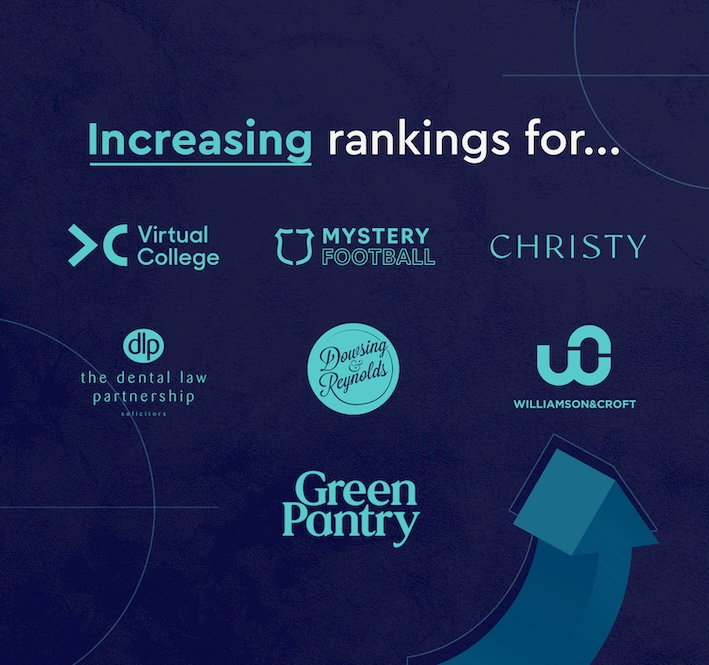
The Innovative Manchester SEO Agency
We’re a UK-wide SEO agency from Manchester. SEO (Search Engine Optimisation) is one of the core strengths we have built our business upon. Over 90% of search engine traffic comes from first-page results, and we have the expertise to get you there.
We use our highly innovative in-house SEO tool suite to evaluate your website’s performance, identifying opportunities that most other SEO agencies often overlook. We understand not just your website, but your industry. What link building looks like across the competition. Who has created high-quality SEO content. Which websites have applied good (or bad) technical SEO, and who’s just fiddled with some H1 tags but neglected the rest of the site.
Effective SEO covers every detail, and Embryo’s holistic approach optimises every aspect of your website. When you choose us, you partner with experienced SEO consultants who genuinely care about your online success.
Take the first step towards SEO growth.
Need an SEO agency to generate results? Get in Touch.
We demystify SEO and work to deliver your brand exceptional search results. Get in touch today.
BCB Group
Using a modern, multi-channel marketing strategy to transform a business into an authority in an emerging market
-
149%
Increase in page views
-
11.7%
Decrease in bounce rate
-
97/100
Core Web Vital score
-
67
Position 1-3 keywords
Why Choose Our Manchester SEO Agency?
From the moment you choose us as the best SEO company for you, we dive right into building a bespoke strategy that aligns with your goals and we then run our 150+ point SEO audit. It doesn’t stop there, however. Our SEO experts spend a great deal of time understanding your sector to see who has the best spread across the SERPs for keywords searched for by your audience.
But what really sets our SEO services apart? As a top UK SEO company, our difference lies in our fresh approach to organic SEO. Manchester may be our home, but our search skills are used to create successful campaigns to companies all over the UK, and even internationally.
- Experience the combined talents of our unified team, made up of SEO strategists and technical SEO experts, content writers and link-building specialists,
- Gain exclusive access to our innovative in-house AI seo tools, which help assess your organic performance against your competitors. With this valuable information, we craft data-led campaigns that make an impact.
- Leave the intricacies of international SEO to us. We’ve helped multiple clients optimise their websites for users in Hong Kong, US and beyond.
- Make the most of our award-winning Digital PR team alongside our SEO work. Collaborating with our other Organic channels gives your online visibility and domain authority that extra boost.
- Effectively target core keywords with our integrated digital marketing services. By combining Google Ads management with our professional SEO services, we increase clicks, profit and traffic.
- Feel at ease with dedicated account managers, committed to your website’s success and your peace of mind.
- Trust our experts to enhance SEO and user experience with industry-leading content marketing. We give your target audience the content they want to see and engage with.
- As a leading local SEO agency, we help your website rank for relevant geographic keywords and appear in front of the right users.
We research, we solve problems, we get your site seen, and you reap the benefits of SEO success. Get in touch to discuss our competitive SEO package today.
Just a few of the Brands That Trust Our SEO and Content Strategies



Our SEO services: Everything you’ll get access to
No matter the nature of your brand, be it a B2C or B2B company with or without e-commerce aspects, we’re equipped to propel your brand towards significant search engine optimisation growth and profitability. No online industry is too niche.
Our wide range of SEO services is complemented by the advanced technologies we use such as Needle and Intermingle, our in-house software.
Here’s just a glimpse into what our SEO company in the UK can do for you:
-
Technical SEO
Not the most glamorous service but one of the most important ones, technical SEO involves all the work carried out to ensure that the indexing and crawling phase is as efficient and optimised as it can be. Technical SEO work is all carried out behind the scenes. So, while the user may not see or appreciate the efforts made from a technical standpoint, having a technically sound website sets the foundations for a strong, reliable and user-friendly site, equating to enhanced visibility.
Tech SEO is a term that is packed with different practices. These practices include the more simple and rudimentary such as optimising your URL structure, adding breadcrumbs to your navigation, editing image filenames, and ensuring your website looks great on mobile. Technical optimisation work can also be extremely complex and include stuff such as structured data markups, JavaScript SEO, XML site map optimisations, and canonical URLs.
Working with Embryo means you gain the added perks of a web development company – any new website projects or site migrations are smoothly managed from all aspects of technical SEO and site architecture. -
Ecommerce SEO
From WordPress to Shopify, any eCommerce website looking to grow their online visibility and increase sales needs a reputable eCommerce SEO agency by their side.
Growing sales and appearing in the search engine results pages for transactional keywords takes a lot of SEO effort. Our SEO specialists will suggest new category pages, optimise product pages, ensure the right pages are indexed and produce a user-focussed content strategy to improve keyword reach. Several SEO tactics apply to eCommerce websites. it’s about knowing how to achieve results based on your site’s platform, implementing product schema markup, optimising for mobile browsing and more.
Luckily for you, we’ve got eCommerce SEO consultants that know what they’re doing.
-
International SEO
Reach new markets, audiences and sectors by investing in international SEO for your business. Made up of various tactics, international SEO is all about expanding your internet presence beyond your business’s country of origin.
The bulk of the workaround global search engine optimisation is about adding a variety of signals to your site to tell Google that your content is suitable for audiences outside of X country. For instance, a unified URL structure that includes the codes of different countries – ‘de’ for Germany and ‘es’ for Spain, for example – is one of the key ways of expanding your reach. As well as URLs, geo-targeting, and hreflang tags are other techniques that will help you be seen by people across the world.
The benefits of international SEO are fairly obvious. Done right and you open yourself up to a limitless market of billions that flock to your website, bringing you more sales and revenue.
-
Local SEO Services
For businesses that want to become the market leader in their local area, optimising for and investing in a local SEO company to help target specific places, towns and cities, is incredibly potent. For example, for an agency like ours, based in the northwest of the UK, we’d always like to rank higher for things like ‘SEO Manchester’, ‘Manchester SEO’, ‘SEO Agency Manchester’ as well as non-local terms like ‘SEO Agency’.
As with international SEO, its ‘local’ sibling is all about structuring a site in such a way that it sends signals to Google’s crawlers to say it wants to be indexed in a particular manner. For local SEO, this would probably involve optimising your Google My Business (GMB) page and building important name, address and phone number citations in websites that are being used by people looking for your services among other things.
Writing and optimising key areas of your site for locally-themed, intent-focused search phrases and terms will help Google to understand just how crucial you are for local searchers.
Also, local SEO can be quite a cost-effective solution as your budgets are focused on just one specific area, not the entire nation.
-
Technical SEO Audit/Core Web Vitals (CWV)
Carrying out an audit is the best way to understand the current state of your website and online presence. Audits done on sites such as SE Ranking or SEMRush will scan through your sites, rate your score out of 100 and highlight major red flags that need addressing. Audits, in many ways, are priceless because they provide you with the information you need to succeed – they are telling you what to do to improve your rankings.
Audits tie in nicely with Google’s Core Web Vitals which is the programme by which they judge websites on how fast they load, their user-friendliness, and technical merits. Search engines obsess over the user experience and are constantly looking for a way to provide the best answer (i.e. website) to the question/search term someone has just typed in. If you can combine the best content with Core Web Vitals scores that are in the 90+ percentile your website is in a fantastic position to be rewarded.
-
SEO Web Migration Services
Undergoing vast, fundamental changes to your website to future-proof it and improve the long-term performance of it all is an extremely delicate and serious job. Undergoing website migrations can be overwhelming and cause a great deal of damage to your site from a search engine optimisation point of view if done wrong. That’s why 99% of the time it’s best to invest in website SEO services. allowing a technical SEO expert to advise on the entire process from start to finish.
Web migration can include moving from one domain to another, restructuring URLs, rebuilding the architecture of your website or a combination of all. Anything you do on your website that fundamentally changes it can be classed as a migration-like practice. They can be extremely beneficial, no doubt, people don’t do these sorts of things for fun. The long-term benefits will arrive as long as the short-term migration is handled with the utmost delicacy.
-
National SEO
If local search tactics target your nearby area and international SEO aims to expand your presence globally, it stands to reason that national optimisation techniques are about getting your name out across the country.
Investing in National SEO is ideal for businesses at a certain growth stage who are looking to expand their brand to places beyond their current location. In a granular sense, optimising for national attention is just a scaled-up version of local SEO where instead of trying to rank for one area, you’re working to be visible across multiple. This type of optimisation also often falls under an Enterprise SEO strategy.
One of the key ways of achieving national SEO success is to create bespoke content for different locations. Having multiple different URLs and pages that target Manchester, Liverpool, Birmingham, and York, for example, would be an example of a national search engine optimisation campaign. Optimising GMB profiles, developing a coherent website architecture, and conducting thorough keyword research are some of the most important elements of national SEO.
-
Mobile SEO
According to Sistrix, around 64% of all searches are made on mobile devices such as phones and tablets. With three out of five people tapping rather than typing into Google, investing in mobile SEO is an absolute must. Almost every industry should think of their internet presence as mobile-first, meaning that everything you do, and every investment you make, should be geared toward making your site run on mobile well first, before you even think about the desktop. This is especially true if you’re in an industry like the Food & Drink sector.
Attention spans are the lowest they’ve ever been and if users land on your site and find that JavaScript or CSS is being blocked, images are slow to load, and the pages weren’t optimised for the device they are on, they’ll simply go elsewhere.
All these little steps need to be resolved if your mobile SEO is to be the best it can be. Once it is, your site will be nothing but a joy for people to visit, meaning they’ll come back time and time again.
-
On-Page SEO
Making all the visual elements of your website the best they can be can drastically improve rankings and visibility. Known as On-Page SEO, this type of service is about getting all the elements of a page that a user can see to be as optimised as possible. On-Page SEO includes considering multiple ranking factors like URLs, heading tags, images, heading tags, alt-text, and metadata.
Working on the front end optimisation has become so important in the last few years as Google’s algorithm has become more nuanced and intelligent. It’s judging how presentable and optimised your site is for the user to the same degree it’s looking at your schema markup and URL structure. The proper on-page investment will aid search engines and users in their quest to understand the context of your website.
More and more, Google is aligning its ranking factors to the factors that make a user want to click on your site.
-
Tech SEO Audit
A technical SEO audit is a process by which you or your SEO agency checks the technical aspects of your website to make sure it’s optimised and healthy. The need to remain relevant and respond to Google et als ever-changing algorithms. Carrying out technical SEO audits once every few months ensures your site is optimised for the newest and most impactful ranking factors.
The stark reality, and the reason why you need to carry out technical SEO audits, is that 93% of clicks are made on page one.
Our technical audits are by their nature rigorous and performed by experts who’ve done hundreds of them between them. We’ll look at the front end factors of your site such as URL structures and the sitemap, as well as back-end elements like indexing and hosting. We also, as standard, examine the areas that impact your websites such as link quality and current backlink profile.
-
Small Business SEO
Loosely related to local SEO, small business search engine optimisation refers to how those new companies make themselves known online. Often with a small investment or available funds, small business SEO is all about maximising budgets and ensuring optimum ROI. While some small businesses shy away from investing resources in search, it should be seen as an opportunity to disrupt the bigger competitors. With so many keywords, small business SEO can be clever and target those lower-value, long-tail keywords that aren’t being covered by rivals.
Startup search engine optimisation can also leverage free tools such as Google My Business and free backlinks from directories or guest blog sites to grow their presence for a cost that is within budget.
In our experience, businesses that have fewer than 50 staff can use clever, in some cases more radical tactics to rank well. Spending time writing long-form content, for example, is just one of the ways that a business can include ontology, earn greater keyword visibility, and steal ranking positions from legacy businesses that have neglected their website. If PPC management is out of your budget, a small business can opt for a basic SEO package to elevate rankings cost-effectively.
-
Video SEO
You might be surprised to learn that videos can be optimised for SEO, as well as text! That’s right, video SEO is a type of optimisation service, one which can be very effective if you’re a business whose main industry is visual.
From the outset, it’s important to know that there is only so much you can do with video SEO, and it’s not as powerful as ‘regular’ SEO. This is primarily because the video itself – i.e. the visual and audio elements – cannot be altered after it’s been filmed. That’s not to say it can’t be beneficial, the transcripts, descriptions, titles, and tags can all be changed and tweaked so that they are more relevant to the terms you’re looking to target.
-
SEO Content
Creating useful, unique and quality content is paramount to any SEO campaign. Sure, on-page optimisations and tech work contribute to performance, but good content is what Google needs to see in order to rank your site highly. At our SEO agency, we have a big team of content and copywriting experts that follow tried-and-tested methods for crafting quality content. We write what your audience wants to see. We don’t keyword stuff or simply regurgitate what your competitors are saying, we work with you to create industry-leading pages and blogs.
Organic Search Campaigns: Our Process for Success
The sustainable growth of an online campaign – whether for an e-commerce or service business – is achieved through a combination of repetitive tasks, hard work, innovative ideas, and taking calculated risks.
Whilst many UK SEO agencies over-promise and under-deliver, our focus on executing a solid content strategy alongside well-thought-out technical search strategies means that no matter the size of your company, our methods will increase your online footprint.
-
1. Research
To create the most high-performing search engine optimisation campaign, we first run our 159-point SEO audit with each point manually checked. Running concurrently with this audit, we identify keywords and key phrases (along with search volume), and look through Google Analytics data to thoroughly identify the existing and potential search audience.
As well as auditing, keyword research, and competitor analysis, we check search engine results pages for ‘ messy middle’ phrases that serve as inspiration for our content plan.
If good, solid on-site, off-site, and industry research is done, then this creates a great platform for SEO techniques to work better from the off.
-
2. Getting to know you
We can’t start producing results without understanding your current position, expectations, goals and key issues. Your dedicated account manager and SEO team will set up a kick-off session, designed to establish a thorough understanding of your business. During this session, we’ll find out about your priority services/products, identify your competitors and target audience, and learn more about the history of your site.
The information we collate from our client workshop will then form the basis of our ongoing strategy, making it a crucial step of the overall process.
Remember: This session is just as beneficial to you as it is to us – it’s a chance to set expectations and understand the deliverables of our SEO services.
-
3. SEO and content strategy
Perhaps the most exciting step (for both parties!), is the creation of our SEO strategy guides everything we’ll carry out for you each month. We’ll take into account any pages that have lost traffic, pillar pages that need some extra attention, technical fixes, existing content optimisation and brand pages with minimal content. This approach allows us to get the basics boxed off before we move into a creative, user-focused content plan that includes long-form content guides and exciting blogs.
We’re an SEO agency that is thorough and careful when it comes to strategy development, it takes time to create something truly bespoke to your website. We don’t reuse or recycle strategies here. We take the best route for you, handpicking a strategy that guarantees to boost organic performance.
-
4. Technical SEO
Improving how a website is traversed by Google, how fast it loads, and how understandable each page is in and out of the context of a site menu system, is at the heart of technical SEO, or ‘on-site optimisation’ work. A few HTML or metadata changes on a page template can have a dramatic effect on how Google robots are able to understand what the theme of a web page really is. Multiply this by several hundred pages, and rankings and visitors can soon rise.
Working from our aforementioned audit, our tech SEO team ensure that all online ranking factors are fixed including checking things like broken links, mobile responsiveness, conversion tracking, and local SEO factors, among regular checks for the number of pages indexed, and inbound links.
-
5. Content writing
Your website is the face of your business. It’s where your target audience makes decisions and opinions about who you are and what you offer, which is why we carefully craft content with your brand in mind. We put in a lot of effort to make sure your content is the best it can be, from creating a TOV document to ensuring we are keeping our finger on the pulse of Google updates, such as the Helpful Content Update which launched in 2022 and emphasised the need for content to be written for humans, not just search engines.
Working with your dedicated SEO account manager, our writers will gather keyword research and begin creating intent-driven pieces designed to rank.
All of our writers are trained to write for search engines and humans, meaning their work is top quality without compromise. Our in-house editors work together with the writing team to make each piece of content the best it can be.
-
6. Workflow, consistency and transparency
We have created first-rate on-page SEO strategies, we love nothing more than to write lots of content, and we harness the power of inbound links, but where we feel that we excel over other digital marketing agencies is in our workflow management and operations.
Whether building citations, creating an outreach strategy, planning for an off-page SEO review, reporting upon a recent uplift in Google rankings, or gaining a new link, we capture every action and record how long it has taken.
This makes our client services so much easier, leaving us more time to work on real digital activity. An informed client is a happy client. And an informed, happy client with improving visitor numbers is a content client.
-
7. Reporting
When collaborating with an SEO agency, you want regular performance updates. That’s where our monthly reports come in handy.
Our highly image-led monthly SEO reports are very easy on the eye, and spend little time in complicated SEO jargon.
Clarity is important to us as a business, and we have never felt the need to over-complicate or inflate our words. You’ll receive an easy-to-read report on your keyword rankings, organic traffic and other key metrics that keep you in the loop of your site’s performance.
Ready for Page 1 Results? Get In Touch.
Let’s have a conversation about your current performance goals, we’re an innovative SEO agency ready to provide the solution and get your website seen.

Embryo were amazing to work with and delivered some incredible results for the brand. The team are so easy to work with and couldn’t do enough for us!
Want to Work with the Leading Manchester SEO Agency?
Speak to our sales team today to discuss how we can help you achieve your online business objectives.
Burgess Pet Care
Burgess Pet Care
-
30.3
ROAS from paid social
-
440%
Increase in online transactions
-
346%
Increase in revenue

Backlinks: How Does a Link-Building Strategy Help?
In terms of optimising your web presence, link-building is an effective, proven way, of establishing authority, trust, and relevance. Simply put, link building is the practice of gaining links that point from a high-domain website back to yours. When indexing the pages of a site, search engines will record links and reward websites with quality backlinks.
Despite advances in search engine algorithms, links remain one of the best ways for search engines to decide what sites are worthy of wide coverage, and which aren’t. However, this process requires producing high quality content and assets to obtain natural backlinks.

The Importance of Quality Links
Getting a bunch of links from a load of random sites without putting in any work is the quickest way to failure, or at the very least, no results at all. The importance of quality in your backlinks is the single most important thing to think about.
Backlinks are endorsements and as you well know not every endorsement is the same. You as a person would want to be endorsed by authoritative people who are well respected in your sector. You wouldn’t want to be endorsed by someone who has no credentials or is looked down on for whatever reason.
Backlinking is the same.
As an SEO agency, we’re committed to working with our DPR team to build authority in an authentic and risk-free way. From creating natural assets to outreaching press releases, our diverse strategies are ready to be applied to your website.
Get in Touch With Embryo Today!

After years of experience dealing with multiple agencies, I almost believed there wasn’t one out there that truly cared about the results delivered. Since engaging with Embryo to manage our PPC our business has gone from strength to strength, which has allowed us to scale at a healthy rate.
Keyword Types
The sheer volume of keywords means that there are plenty of types into which they are segmented.
Choosing the right keywords, as you’ll see, is important. But before you go about doing that you’ll need to know which types of terms and phrases are out there so that you can segment and tailor content differently. Working with an experienced SEO agency offering PPC management services will ensure you explore the right keywords, from a paid and organic perspective.
-
Branded and Unbranded
The branded phrases are those that include a brand’s name as part of a larger term or are just the keyword themselves. Branded keywords are usually a good indication that a company has a good market share and is known by its audience. Unbranded keywords are those which don’t feature a company’s name. Both come with benefits, the intent behind branded terms is more commercial. If someone is typing a company’s name in, the chance of them purchasing something from them is higher because they know where to go.
-
Page-Specific and Seed Key Terms
Seed terms are the broad keywords that could cover a multitude of subtopics. These types of terms are usually searched for in the early stages of the buying journey. On the contrary, page-specific terms related to those phrases are a bit more specific and are looking for one thing.
Think of it like this, the seed phrases will be relevant to most of your website whereas the page specific ones will only really be relevant to one, maybe two pages on your site.
-
Short and Long-Tail Keywords
SEO keywords are so many because they can be almost any length. These are categorised into short and long-tail terms which are sometimes called ‘head and tail’ terms.
Generally, the shorter the keyword, the larger the search volume and the harder it is to rank for it. Whereas a long-tail term has lower search volume but is usually far easier to rank for. The keyword “socks” for example is going to take longer to rank for than “What are the best socks to wear with hiking boots?”.
Real inroads in search engine traffic can be made by aiming for those mid to long-tail keywords as they tend to have higher converting traffic.
-
Customer Journey Terms
A whole bunch of Google search terms can be segmented via the classic buyer journey. Different keywords will provide clues as to what stage in the buying journey someone is.
These clues can be used to leverage content toward them. The ultimate goal is to attract all the traffic from search engines for all the different buying phases so that you’ve constantly got different people, at different stages in the pipeline, coming to your business.
-
Local, National, and Global Phrases
These segments of phrases explain themselves in a way. Local keywords are those which include terms that are relevant to the area in which you are based or feature a term that’s unique to an area. National phrases expand on that and focus on entire countries, with global terms not having a geographical bent and being more generic.
-
Terms Searched by Audiences
Audiences, target markets, and sectors all type different things that are associated with them and their identity. For instance, Manchester United fans may type terms that are related to their club as they are interested in the team and see it as part of their identity.
These terms allow you to align your marketing to the customers and learn what types of things they are searching for. You write content to that and you have a pretty successful, if niche, strategy.
-
Evergreen and Topical Terms
Evergreen terms are phrases that never lose their relevance and are not affected by the time of year, outside influences, or changes in trends. Topical terms are the exact opposite and will suffer peaks and troughs depending on when people are interested in them and are searching.
-
Primary and Secondary Phrases
A primary term is the main phrase you’re looking to rank for when writing a blog or a piece of content. As with many key topics, there are usually 5-10 sub-topics within it, these are what secondary phrases are, the keywords that will help support the performance of the target phrase.
Keyword Research Tools We Leverage to Maximise Organic Success

Ahrefs

Sistrix
SEMRush

Google Trends

Answer The Public

SpyFu

Moz
Google Search Console

WordStream
A Fresh Approach to SEO Content
The content on your site is the fuel that powers your search engine traffic and rankings. At least 9/10 of our clients come to us with a need to add more content to their website. Not only to rank for keywords but to provide their target audience with useful information, too. It’s a key factor in SEO marketing that often gets overlooked by people who don’t believe in the power of the written word or come to it with preconceptions about long-form content and how it can convert into revenue.
At Embryo, we class ourselves as a content-first SEO agency among other things. We’ve seen first-hand just how powerful user-first, informative content can be.
On a fundamental level, the words on your website will help to persuade, engage, or excite people to buy your product or service. Without a sufficient amount of content, you’re not going to win over enough people with that as an internet marketing strategy.
Content marketing has many purposes, and as well as acting as a tool of persuasion to users, it’s the most proven way to organically rank for the core terms and phrases you want to rank on page one for.
Writing words on your site is how you show Google you know what you’re talking about and signal to them which of the competitive keywords you want that particular page to rank for. There are some instances where these goals of persuasion and organic rankings can be achieved by writing 300-500 words but in this day and age, long-form content is the passport to success.
The term ‘content’ covers a whole host of types, all of which have different benefits and features. The key for your reader is to decide where to spread your content investment. It depends on a thousand different factors – e.g. what your KPIs are, the intent behind your audience’s searches, and what keywords you want to target.
Types of Website Content:
-
Blogs
A very common type of content that can be leveraged by virtually every business in any industry. Blog writing allows you to write a lengthy answer on a topic to do with your business or a competitive term that your audience is regularly searching for the answer to. Blogs allow you to increase the total number of keywords you rank, and, as a key ranking factor, show to search engines that your website is active. Further, blogs give you a platform to link to important pages that you want traffic to go to.
-
Whitepapers
These standalone documents are great lead generators as you can put the paper behind a ‘paywall’ where users have to submit their email addresses to access it. Whitepapers can be about an upcoming event in your industry or a study that you’ve taken that provides people with new and interesting data. These documents can also set you apart as a thought leader in your industry.
-
Product/Service Page
These pages are probably the most important on your site. The pages that showcase the products and/or services you sell need to be your main focus if actual content has been hard to come by in recent years. Within these pages, you should be looking to target one highly searched term and then within it mention several core terms that underpin it. Content on this page should look to answer every possible question about the keyword that you’re aiming to rank for. FAQ sections are perfect for these pages as they allow you to answer several related long-tail key terms/questions.
-
Case Studies
What better way to showcase how brilliant you are than writing about how you helped a customer or client. Case studies are proof of your abilities to help people, and within them, you can provide stats, figures, and other data. Once written, whole case studies can be shared on social media or snippets can be broken up into smaller pieces of content.
-
Infographics
Not strictly ‘content’ per se, but infographics are like whitepapers in that they are great at lead generation and can be shared across social media. With the right image optimisation tool, these infographics can be found via Google images.
Let Our SEO Team Do the Hard Work, All You Need to Do Is Enjoy the Results. Contact Our Team Today.

By far the best agency I have ever worked with! Every single member of the team is a pleasure to deal with. They're absolutely brilliant at what they do! Highly recommended.

Understanding Intent: Why Do People Search?
Search intent is how we describe the ‘Why?’ behind a search query. Every time someone types something into a search engine, they are doing so for a reason. These reasons can be mundane or very serious – from searching for a funny GIF to looking for a specific insurance policy.
The intent behind a search gives us, the marketers, a lot of clues as to what they want to find by searching for that particular term. They could be looking for a particular product, want more information about something happening in their local area, or have a specific brand in mind that they wish to purchase from. There are millions of reasons why people search.
Understanding audience intent is vital if you want a successful SEO strategy. Google itself has put a great deal of emphasis on refocusing its algorithm to better serve search intent, which should give you some indication as to the importance of understanding the ‘Why?’ behind the query.
While the traditional ranking signals and markers – backlinks, keywords et al – matter, the fact is that if your page doesn’t satisfy the intent of the search, you’re never going to rank.
Before you begin writing your content that targets a particular keyword, break down the term and understand what it’s saying.
For instance, an example keyword such as “Quick Vegan Recipes” might not seem that interesting but, when broken down, there is a huge amount of intent behind that search.
- “Quick” – The intent behind that is fairly obvious. They don’t want to be spending hours cooking, anything under 20/30 minutes should be your aim with your content/recipe.
- “Vegan” – Creating your content cannot involve anything that involves an animal – be it meat, cheese, eggs, or other animal-based products.
- “Recipes” – The user isn’t interested in ordering a vegan takeaway, they want something homecooked.
If a user searches for quick vegan recipes, lands on your site and your particular recipe takes 1 hour to cook, they’re simply going to leave your website until they find your competitor’s website which has a recipe that takes just 15 minutes! What they’ve done is understand the intent of the query.
To enhance that intent, be sure to create a great user experience. It doesn’t matter if your content is exactly what the user is after, if it’s horrible to read through on a phone, or is taking ages to load, they’ll go elsewhere. Make sure that your text size is big enough, ensure your content is split up with headings so that users can find their answers quickly, and don’t spam them with popups.
How Embryo Creates a Bulletproof SEO Strategy
SEO checklists tend to be fairly generic and not very helpful to the reader, there are a lot of basic things in there that don’t go beyond ‘do this, do that’. To create a bulletproof SEO strategy we think about the”why?” behind everything we’re doing. Further, everything must be aligned back to your overall KPI. Sure, great keyword rankings are important but if they don’t bring you new revenue or increased traffic, then what’s the point?
Whether doing SEO in-house, or using one of the UK’s top SEO companies like Embryo, checklists done correctly (and then completed) can produce results months ahead of a run-of-the-mill checklist.
-
Set Goals from the Very Start
Setting goals is so important when making a plan for your search engine optimisation tactics. Goals will ensure everyone knows what the point is behind what they are doing. In addition, work will be done with that goal in mind, making it more relevant and impactful.
With your goals set you can start to decide which platforms and types of content to invest your time in, as opposed to just throwing money at things and not knowing if they are relevant to you. If performance isn’t where you expected or it’s not helping you get to where you want to be, you can make small adjustments because you set goals at the start and have a north star to face it.
Your indicators of performance could be anything, they just need to be specific, like doubling the traffic in 6 months, increasing sales by 30% in one year, or increasing the number of page one keywords to 50. Whatever they are, goals will help you measure ROI which will allow you to budget more effectively going forward.
-
Research Your Competitors, What Are They Doing?
No matter your industry, you’ll have competitors who are online and ranking on page one for the keywords that are just as relevant to them as they are to you. So when the time comes for you to invest in SEO make sure you research the content your competitors are putting out. Check out their backlink profiles, keyword rankings, online reviews, blog strategy, everything. After all, they are winning in the online world.
Analyse your competitors and the people who are ranking for the key terms you want to rank for. The latter may not be direct competitors but at the end of the day, they are doing something right and are therefore worthy to be analysed.
-
Undergo Extensive Keyword Research
It sounds obvious but with it being so integral, it’s certainly worth a mention. Undergoing extensive keyword research is vital if you’re going to create targeted content that ranks for what you want it to rank for.
You wouldn’t believe the number of businesses that write and write and write without thinking about what it is they are targeting. Advanced keyword research allows you to avoid cannibalizing rankings (this is where two pages of the same domain end up competing with each other for the same ranking) and reducing the impact of the pages that you’ve worked so hard to complete.
Keyword research equals better ROI, there’s no greater incentive to do it than that.
-
Align What You Create with the Intent behind the Targeted Keyword
Your content could be the wittiest, most engaging piece of work you’ve written but if it doesn’t match the intent of the query it’ll never succeed. Certain keywords you’re looking to target may be driven by a particular type of intent that just doesn’t match what you’re creating.
Be sure to analyse the intent of the first 10 or so results for a keyword, you’ll get a better understanding of how the content is matching the intent.
-
Optimise the Back End of Your Website from the Very Start
A car is only as good as the tires it runs on. The same principle applies to a website. If your website isn’t technically optimised then your on-page content isn’t going to perform to the best of its abilities. Providing the best user experience starts with back end optimisation – removing bloated code, reducing image sizes, ensuring your site has breadcrumbs, these three things just scrape the surface of what needs to be done from a backend perspective.
SEO web design is a great opportunity to get these back-end practices in as you’re building them rather than having to put them in after. Doing them as you build them is a great way of ensuring your website’s launch has the fullest possible impact.
-
Measure Results in 3-Month Chunks
SEO is a long game, with so many different pieces of content to index every single second, getting ranked online can take a while. Once you’re indexed, the process of moving through the rankings takes a great deal of time. All the while you should be looking to add fresh content to that page to further enhance its relevancy and potency.
Once your blog, page, or entire site is published, the hardest part is to wait and let it index. You really should wait 3, 4, 5, or even 6 months to check your website’s online visibility, rankings, and traffic.
Nine Things An Organic Search Strategy Needs
1 Original content across all pages
2 Relevant internal and external links
3 Great Core Web Vitals
4 A website that is fit for mobile
5 Easily navigable pages
6 Relevant calls to action across the site
7 A good balance of short and long-tail keywords
8 Patience, SEO success takes time!
9 Demonstrate Experience, Expertise, Authority, and Trust (E-E-A-T)

I Haven’t Got All Day! How Long Does SEO Take?
It can be tempting when looking to hire an SEO agency to find that one that offers quick wins, immediate results, and ‘guaranteed’ success. “Get ranking on page one in just a few weeks”, they’ll cry! They might even have a convincing argument but the truth is that SEO simply will not properly impact your business in weeks, it takes months.
The length of time SEO takes also depends on the goals that you want to achieve from it and the fact that algorithms and search engines have become far, far cleverer. A few years ago, SEO agencies would’ve been able to provide their clients with ‘quick wins’ by dumping backlinks from useless websites and spamming their websites with keywords. They’d look fantastic to their clients but these wins would only last as long as Google didn’t update their algorithm, the moment they did, sites like that would suffer and digital marketing agencies wouldn’t look as brilliant as they once had.
Nowadays, Google and Co recognise and reward hard work, authentic link building, and overall visibility. These practices take far longer but they are platforms from which long-term SEO performance can be founded. These things cannot be cheated anymore.
It may be tempting to look into ‘quicker’ internet marketing services such as a Google AdWords agency to get instant results. However, for sustainable, long-term success, SEO should not be overlooked. Patience is key!
While it takes longer, businesses should take comfort from the fact that what you are doing is the proven method to success.

Understanding Google’s Algorithm: How to Track It, and Why
Underpinning everything that is done on Google, is its algorithm. It’s multiple algorithms, not just one, that decides when and where to index content on the web. The search algorithm is there to make sense of the billions and billions of web pages that are set live every single day – without it, the internet would be chaos.
The algorithms look at all the aforementioned ranking factors such as search query, speed of website, location, relevance and other things in a fraction of a second and provide the user with – nine times out of 10 – the right answer.
In this fast-paced world of content-hungry people, Google must constantly refine its algorithms and the way it scores content to keep up with changing intent and trends. As a result, it’s estimated that the search engine giant changes its algorithm around 150 times a year, which works out at around one every two days!
The algorithm is cloaked in secrecy and despite having a good inclining, there are only a few factors that we’re sure Google values, which are:
- How fast your website loads. Page speed is so important to Google because fast websites mean users get their info quicker, thus improving their experience.
- Your content has to be relevant to the keyword that it is attempting to rank for.
- A well-designed website is always going to be preferred by search engines because they, again, provide the user with the best experience.
- The quality of links that point back to your site is a good indicator of how authoritative your site is.
- Having a website that looks as good on mobile as it does on a desktop is an important signal to Google.
- Having SSL certification and thus an HTTPS Status is a good sign to Google that you have a secure website.
- If you have high bounce rates and not many returning users, it’s a sign that your user engagement is low, amend this and you’ll find your favourability among Google increases.
As an SEO agency, proactively responding to algorithm changes is at the top of our priority list.
How Many Times Does Google Update Its Algorithm?
The Google algorithm is almost certainly tweaked every day. However, many of these updates are so minor that you don’t need to pay much attention to them. What will affect your website are the one or two major updates that Google releases every year, such as Panda in 2011, Penguin a year later, and Hummingbird in 2013. Many websites and SEO agencies disappeared after each of these updates due to malpractice that these updates remedied. These updates are for various reasons and will have a direct on your page performance if you’re either not aware of it or not ready to adapt.
You must be aware that algorithms can change the search landscape of your industry in a heartbeat. Luckily, there are plenty of things you can do to ensure you’re up to date about any changes being made.
How to Avoid Being Punished by Google’s Core Updates
- Make sure your website is optimised for mobile from the get-go. Approach site design as a mobile-first practice and you’ll avoid major punishments from future updates.
- Review all the internal links across your site. Check that they work and make sense within the context of the page. Inbound links that are up-to-date show that your website is ‘alive’.
- If your website is slow and unresponsive you bet your page one rankings that are going to be heavily punished in the next update. Having a fast website provides the user with the best experience which is Google’s number one priority.
- Keep all the content on your website unique and avoid duplicating it at all costs. It might seem tempting to copy some work here and there but, without sounding harsh, it’s lazy, and Google will spot it, and reward other sites over yours.
- Rather than duplicating content, invest time and resources into creating informative, rich content that looks to authentically answer the key terms.
- Related to point 5 is the need to naturally include your target keywords. Stuffing phrases into the pages isn’t for the benefit of the reader which means it will be punished in a Core Google update.
- Make sure your site is easily navigable – a website with good architecture will provide the user with a more pleasurable experience and make it easier for Google spiders to crawl the site.
Quick Tips to Improve Your Search Rankings
If you’re reading this page and are panicking because your SEO rankings or website performance are nowhere near where you want them to be, don’t worry. Virtually everything in the world of search marketing is fixable, providing you have the patience, tenacity, and resources to make changes.
In a broad sense, improving your rankings starts by following the best practices we’ve spoken about regularly on this page. So, make sure you have unique content (that you’re updating and adding to regularly), and outreach to sites to gain inbound links that point to your key website pages.
All these practices, plus many more, are all things you should regularly be doing to constantly improve your rankings and performance.
Partnering with a web design and development company can also help to uncover underlying issues with UX or suite structure that may be blocking SEO performance. Make sure to explore all possible avenues to identify quick win opportunities, but don’t neglect long-term tactics.
If you want to immediately see an impact, here’s what you should do.
-
Check Your XML Sitemap
Your XML sitemap describes how your site has been built in code form. Once you’ve downloaded it you can compare it to a regular sitemap and spot any errors or inconsistencies. These errors can include 303s and 404s, missing key pages, no indexed content and orphaned URLs – all of which can impact the fundamentals of your site.
-
Check That Google’s Crawling Your Site
If Google isn’t crawling your site you’re invisible online so it is vital you know whether or not your site has been crawled by their spiders. You can use Search Console and click ‘Fetch as Google’ in the ‘Crawl’ section. Once you’ve put your main URL in there you can request that Google indexes your site.
-
Find Out How Many Pages Are Being Indexed vs How Many You Have
This step is super simple. Head to Google, type “site: {ENTER YOUR WEBSITE}” then view the number of results that are shown. This will tell you how many pages Google has indexed. If you then view your website from the backend, you can see how many pages you have on your site. If the numbers are drastically different, you’ll be able to see whether or not you have a problem with duplicate pages.
-
Set Goals on Google Analytics
In your Analytics, you can set and determine what goals you want to track. It could be when someone signs up for your newsletter, makes a reservation, or completes an online payment. Choose the goals that are relevant to you and you’ll be able to judge the value of your current SEO practices.
Invest in a Trustworthy SEO Agency.
Contact us today and see how we can transform your online footprint.

There aren't enough superlatives to describe the Embryo team and the digital marketing solutions they've provided for our business. We've been working with the team for over 18 months, and I can say that they are an extension of our in-house marketing team and consistently go above and beyond with service levels, creative solutions and input, as well as supporting our day-to-day efforts.
SEO Agency FAQs
-
How does Embryo report on SEO?
Your business goals and KPIs form the foundation of our SEO reporting. Our process involves curating data boards from GA4, pulling keyword ranking reports from SERanking and summarising the work carried out. Each account receives a monthly report from us, along with a written commentary and optional follow-up call. Our SEO account managers and client service managers work hard to ensure clients understand what we’ve done, why we’ve done it and how it impacts performance month-on-month and year-on-year. If you
-
Can I sign up for a cross-channel retainer across SEO and other departments?
Yes! Our proposal process involves diving into various segments of your website and audience, and understanding where users come from. SEO helps to improve your organic performance, whilst cross-collaboration with digital PR helps broaden brand awareness and build authority. Paid media generates more engagement and revenue. Website design services make your website engaging and attractive. A rounded digital marketing strategy captures every stage of the buyer journey, maximising your success online.
-
How do I get an SEO proposal?
We don’t whack together any old proposal. We use available data, competitor information and your KPIs to produce a data-led SEO proposal. We can have a casual chat, and speak to you informally first, should that be your preference. However, our indicative workflow and thoughtfully crafted strategy are best presented to you. If you’re a marketing manager or CEO looking for a new SEO partner, get in touch with us with your inquiry, and we’ll take it from there.
-
Will I get a dedicated SEO account manager?
Exceptional client service is incredibly important to us. This is why each of our clients gets a dedicated SEO account manager, content writer and client services manager. Beyond this, togetherness is what sets our agency apart. So we work with the wider delivery team and strategists to ensure we’re delivering high-performing work. After all, a team of brains is always better than one!
-
Why should I choose to work with an external SEO agency?
SEO is what we’re experts in. We’ve evolved intuitive tools, developed tried and tested strategies and hired industry specialists to generate performance for our clients. We have access to industry trends, allowing us to continually adapt and put those new trends and guidelines into practice. An SEO agency like Embryo doesn’t merely exist to create content and help you rank for keywords, we become a solid arm of your business. The main difference is that we have the time and resources to give your website the TLC it deserves, whilst you focus on expanding and maintaining your business.
Why settle for an in-house SEO individual when you can rely on the expertise of a dynamic agency?
-
Do I need an SEO agency?
To come to the correct answer for your business you need to look around you and consider your current capabilities, knowledge, and skill level. The need to work with SEO experts is all based on where you’re at in your growth journey and there are dozens of scenarios where you may or may not need to work with a team who can accelerate your growth online. For instance, if you have an in-house marketing team that has a solid understanding of SEO then the need to work with an agency may be less than a business that doesn’t have dedicated staff members who work on growing the brand. Or, if your website isn’t getting enough relevant web traffic from your audience, working with a team who knows how to help achieve this could be extremely beneficial to your business. Another scenario we see when brands get in touch with us is that they’ve been caught out by a Core Update which has seen their traffic dip severely (virtually overnight, or at least that’s what it feels like) and they need the help of an agency to right the ship. So yes, in short, there are probably more scenarios than not which would lead you to needing an SEO agency.
-
How soon can I expect results from SEO?
There is no cookie-cutter answer to this question. Before thinking about results, it’s important to first appreciate the scale of Google’s search engine. Every day there are millions of pages which go live on websites, all of which want to be scanned and indexed by Google. This takes time. SEO results can be sped up if you have a website which has been around for a while and has had content published on it regularly. On the other hand, new websites or those that are of poor quality will take longer as they’ve yet to make an impression on Google. It also depends on what results look like to you – if you want to target hyper-competitive keywords like ‘Black Nike Trainers’ it might be months, even years before you see a page one ranking. While there are several quick wins that a good quality website can achieve by carrying out routine technical optimisations results that impact revenue or leads can take between three to six months.
-
How much do SEO services cost?
The majority of SEO services are charged on a retainer basis whereby a certain amount of money per month equates to a pre-agreed number of hours that a person or team will work on your website. The number of hours (and thus the amount of work that can be completed on your site) can be increased if you have the budget to increase your investment. One thing to note when it comes to paying for SEO is to watch out for those that promise miracle results in a short space of time for a small fee. On the whole, these promises do not result in the transformative results promised. That’s not to say you need to spend tens of thousands of pounds a month to guarantee results, it’s about finding the right monthly retainer or project fee for your business, one that you can afford, without falling for cheap tricks or black hat SEO techniques.
-
Is Embryo a specialist SEO agency?
We are, in that we have SEO specialists in our team and our Organic department (which consists of search engine optimisers, content writers, and digital PR specialists) is our largest team with around 19 members. However, as well as being specialists in search engines we also have teams that can create eye-catching paid social campaigns, PPC and affiliate marketing campaigns that can convert audiences into buyers.
-
Why choose Embryo as your SEO agency?
There are lots of agencies out there, there is no denying that. Up and down the country there are teams of marketers helping businesses so why not choose one of them instead of us? Well, while these agencies do do good work none of them have the proprietary technology that we at Embryo have. Living up to our value of ‘Seeing what others don’t’, we built Intermingle and Needle so that any brand, in any industry, could see where they stood online within the context of their competitors. As well as technology we have a client services department that acts as the bridge and communicator between the brand and the delivery team, ensuring that there is always a familiar and friendly face ready to answer any questions and action requests. Our team of strategists also work alongside all departments to offer their perspectives and impart their decades of collective experience to find innovative solutions.
-
What input does Embryo need from its SEO clients?
Your input in those early phases will help us better understand your business, its priorities, and what your version of success looks like to you. We can then use this information and mould our SEO strategy accordingly, ensuring that what we’re doing aligns with your overall goals as a business. There are, of course, very basic things we need from your brand to successfully carry out work for you such as website logins (if we have agreed to upload content on your behalf, for instance). In addition, prompt approval on content provided by our team and agreement on short-, medium- and long-term strategies all make for a smoother process for all parties.
-
Does Embryo offer International SEO?
Yes! International SEO can help brands unlock new territories and audiences who are interested in purchasing the goods and services on offer. We can, and have, scaled clients who are based in the UK and helped them start earning revenue from places in Europe and beyond. It is important to recognise that to be successful organically, abroad, you need to have a website that is set up to be found overseas by people – which is something we can take care of. As well as that, you also need to have the physical infrastructure in place to be able to offer goods and services to other countries. If you don’t have the latter, it may not be the right time to invest in international SEO, instead, focus on your native market or work to build your business’s physical infrastructure.
-
Does Embryo work in partnership with large in-house teams?
Certainly. Embryo’s array of teams can work with large in-house teams and plug gaps where your team might not have the expertise. So, while you might have a great social media team, we can assist with PPC or SEO campaigns which can complement your in-house team’s work. Beyond that, we can offer consultancy and training services that can advise and train your in-house team, ensuring long-term success. Essentially, Embryo’s team can be whatever it is you need for your business at a given time.
-
How does content contribute to SEO?
Content is one of the core pillars of our entire SEO service, along with authority (link building and digital PR) and technical SEO. When Google crawls your website, it needs to see useful, unique and relevant content on your website to rank it for the right keywords. Content is the most effective way of telling search engines and people about who you are and what you offer.
-
What happens once I sign up for an SEO retainer?
So you’ve decided to choose Embryo, we’re excited to get started. After initial conversations with our sales team and client service team, we’ll set up a kick-off call. Here, we’ll tell you more about how we work and find out more about your KPIs and focus areas. Then, we’ll get started with refining your strategy and deliverables. You’ll receive consistent updates from us, content to sign off and reports every month.
-
Can I work with Embryo if I’m outside of Manchester?
Of course! Whilst our office is based in Manchester city centre, our clients are all across the country. We can do meetings in person or online, whichever best suits you.
-
How is an SEO strategy created?
Utilising our various in-house tools, we strategise based on where you are currently in your industry from an organic perspective. We’ll look at the technical soundness of your site, your authority and backlink profile, content and opportunities. Our tools show us how your competitors are performing and analyse what you could be doing more of (or need to improve on). From here, we’ll spit resources between our various organic channels to get performance.
-
Does SEO increase sales?
SEO campaigns can grow traffic from relevant audiences by helping your brand be found for key terms. Then, once on your site your audience views your valuable, optimised content, and if convincing enough, members of that audience will contact you. Optimising for search engines can increase your sales by growing the quality and quantity of the leads coming through to your site.
-
Is SEO important for small businesses?
More than ever, with Google’s renewed emphasis on intent, smaller businesses can look to compete with bigger businesses in their sector by working hard to offer, as well as a slick website experience, and great content that is expansive and meets the needs of the user. Beyond this exciting new opportunity, SEO has always been important for small businesses as it’s the marketing channel which works to grow your business organically online. Organic marketing is one of the most sustainable ways of growing an online presence. When following good SEO practices and producing great content small businesses can start to rank for the key terms that matter to them.
-
Is SEO better than Google Ads?
It is not so much a question of better, it’s more a case of what is right for your business. If you want to grow your business organically, earn traffic from interested buyers and keep this up for a long period of time then SEO might be more appropriate for your business. Alternatively, if you have a strong SEO presence but want to look for quicker conversions from audiences with high buying intent then optimising your Google Ads account might be the preferred route for your brand. In our opinion good, sustainable marketing efforts should involve multiple channels to maximise your audiences across all stages of the funnel. For example, a user could find your brand organically via a blog that imparts some valuable information and then when they are ready to purchase they find your paid advertisement across the numerous Google networks (such as YouTube or banner ads on other websites).
-
How will I know you can deliver SEO results for my industry?
We’ve worked with a great deal of industries at Embryo and we have found that for the vast majority of them, their goals can be split into one of two camps – leads and online sales. And for both, SEO can work. Generating good quality leads takes time and requires a fair amount of trust between the search agency and the client. SEO can help with lead generation by creating content that imparts knowledge and gives value to readers who, in time, will go to the brand that has worked hard to earn their trust. Alternatively, SEO can help to achieve goals that are more product-led and e-commerce-based. With optimised content on bespoke product landing pages, campaigns can help brands be found for keywords searched by people who are ready to buy there and then.
-
How does payment for services work?
Payments for SEO depend on whether you partner with Embryo for a one-off project or a retainer. Payment for project work is often taken in advance whereas payment for retainer work occurs monthly via GoCardless.
-
How does Embryo report on performance and how often is it?
Official reporting occurs once a month and is sent to you early in that working month. This report will contain results which are relevant to your business and its goals. There is no boilerplate report, each one is unique to you. We avoid vanity metrics that look good but are meaningless to you and instead focus on improving the performance indicators that mean your business is growing.
-
Are you SEO consultants?
While at our core we are an SEO agency that looks to run campaigns on your behalf, should you have an in-house team of marketers but want to work with a team that can provide clarity, direction, and insights then we can act as consultants.
-
How much do I need to know about technical SEO? It sounds confusing
In some instances, technical SEO can be confusing. However, you don’t need to know a lot about the nitty-gritty of technical SEO, that’s what our team of experts are for. What is helpful is how to think about technical SEO. And the way to think about ‘tech SEO’ is that it involves a series of small things done very well, and in some cases, done regularly. Good technical SEO is about good practices and behaviours that, done concurrently, add up to long-term success. Things such as ensuring images are uploaded with relevant file names and alt text, removing redirects to pages that no longer exist, and making sure that you are internally linking to other relevant pages on your site are all examples of technical SEO services. All are relatively simple things but need to be done once and then done consistently to ensure your website is technically sound.
-
Do your team optimise our title tags and meta descriptions?
Yes, of course, this is something that we would do as a matter of course and the amount of tags and descriptions that need optimising would depend on the results from our audit phase. While title tags and meta descriptions are not traditional ranking factors, optimising them forms part of our wider best practices that we follow along with image optimisation and ‘cleaning’ content of unnecessary HTML code.

















